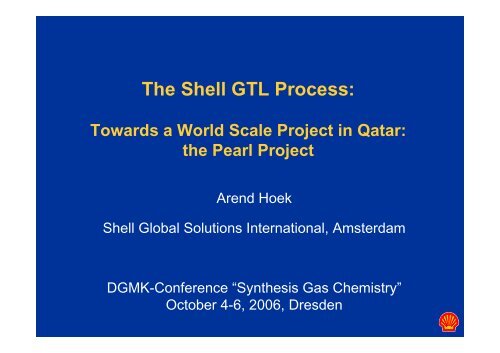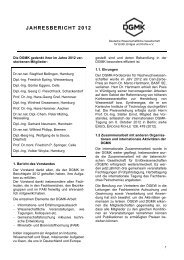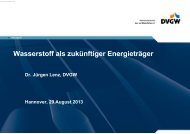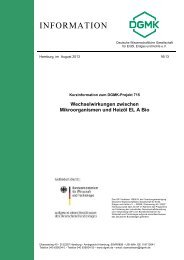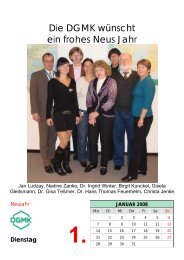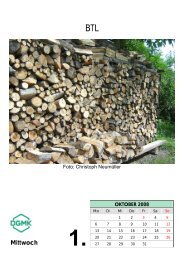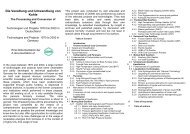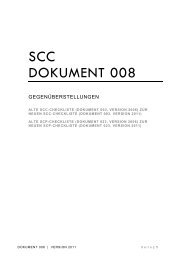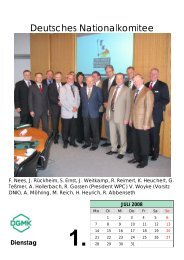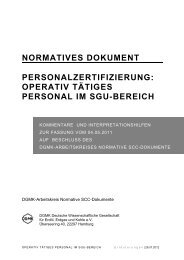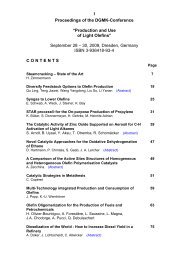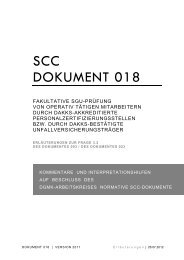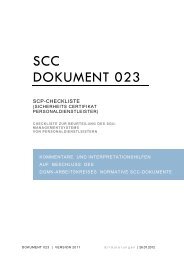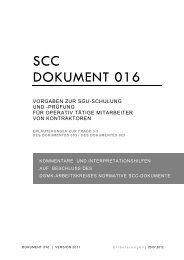You also want an ePaper? Increase the reach of your titles
YUMPU automatically turns print PDFs into web optimized ePapers that Google loves.
<strong>The</strong> <strong>Shell</strong> <strong>GTL</strong> <strong>Process</strong>:<br />
Towards a World Scale Project in Qatar:<br />
the Pearl Project<br />
Arend Hoek<br />
<strong>Shell</strong> Global Solutions International, Amsterdam<br />
<strong>DGMK</strong>-Conference “Synthesis Gas Chemistry”<br />
October 4-6, 2006, Dresden
2<br />
Contents<br />
� Introduction<br />
� F-T catalysis<br />
� Hydroprocessing<br />
� Bintulu learning<br />
� Evolution<br />
� <strong>The</strong> Pearl project (Qatar)<br />
� Conclusions
3<br />
Raw<br />
Natural<br />
Gas<br />
What is Gas To Liquids (<strong>GTL</strong>)?<br />
Methane+ Oxygen Hydrogen Carbon +<br />
monoxid<br />
e<br />
Fischer-Tropsch distillates+<br />
Water<br />
Catalyst<br />
Gas<br />
<strong>Process</strong>ing<br />
Ethane<br />
LPG<br />
CH<br />
4<br />
O 2<br />
Condensate<br />
Sulphur<br />
Syngas<br />
Manufacturing<br />
Syngas<br />
CO + 2H 2<br />
Bintulu SMDS<br />
Fischer Tropsch<br />
Synthesis<br />
-CH 2 -<br />
Products<br />
Work-up<br />
Conversion of natural gas to clean, high quality fuels<br />
& products via the Fischer Tropsch process<br />
LPG<br />
<strong>GTL</strong> Naphtha<br />
<strong>GTL</strong> Gas Oil<br />
n-Paraffins<br />
<strong>GTL</strong> Base<br />
Oils
4<br />
SGP Upscaling: Experience + Modelling<br />
Upscaling<br />
based on<br />
design criteria<br />
used for 50<br />
years<br />
Upscaling<br />
evaluated by<br />
fluid flow and<br />
reaction<br />
modelling<br />
• High quality Syngas:<br />
H2/CO 1.8 mol/mol<br />
CH4 slip < 0.5 vol % dry<br />
CO2 content ~ 2 vol % dry<br />
Carbon to CO ~94 vol %<br />
• Modelling tested against Bintulu<br />
• Sufficient reactant mixing time<br />
• Minimum temperature fluctuations<br />
near the refractory wall and no hot<br />
spots<br />
• Dimensioning to achieve long<br />
refractory lifetime<br />
• Burner front design checked by<br />
finite element stress analysis
5<br />
Technical challenges<br />
� Carbon efficiency<br />
- selectivity of catalysts<br />
� Capex<br />
- process intensity<br />
� Availability<br />
- catalyst stability<br />
- robustness<br />
� Materials<br />
- resistance against corrosion, erosion,<br />
metal dusting<br />
� A <strong>GTL</strong> plant is mainly a UTILITY complex<br />
- efficient use of steam
6<br />
Advantages<br />
� All in house technology<br />
� No boundary issues between process<br />
step<br />
� In house catalyst manufacturing<br />
� No secrecy issues
7<br />
Contents<br />
� Introduction<br />
� F-T catalysis<br />
� Hydroprocessing<br />
� Bintulu learning<br />
� Evolution<br />
� <strong>The</strong> Pearl project (Qatar)<br />
� Conclusions
8<br />
Fischer-Tropsch synthesis<br />
� Promoted Co catalyst<br />
� Fixed bed multi-tubular reactors
9<br />
Schulz - Flory FT Kinetics<br />
CO<br />
CH3<br />
α<br />
C2H5<br />
α<br />
α<br />
CnH2n+1<br />
1 − α<br />
1 − α<br />
1 − α<br />
CH4<br />
C2H6<br />
CnH2n+2<br />
α<br />
n-1<br />
α<br />
1−α<br />
Probability<br />
= probability of chain growth<br />
1 - = probability of chain termination<br />
(1 − α)<br />
α (1 − α)<br />
(1 − α)<br />
Cn =<br />
(1 − α)<br />
α<br />
α<br />
n
10<br />
<strong>The</strong> Relevance of Catalyst Selectivity<br />
%m<br />
100<br />
80<br />
60<br />
40<br />
20<br />
0<br />
CWax<br />
1-2<br />
C3-4<br />
Fuel gas<br />
C 5-12<br />
LPG<br />
Tops/Naphtha<br />
C 12-19<br />
Gasoil<br />
0.75 0.80 0.85 0.90 0.95<br />
Co (classic)<br />
Probability of chain growth<br />
Fe (classic)<br />
New catalysts<br />
C 20+<br />
Wax<br />
Produce<br />
wax<br />
Crack<br />
back
11<br />
Preferred process lay-out<br />
Producing max. heavy wax (max. chain<br />
growth probability leads to:<br />
� High efficiency (liquid yield)<br />
� High gas oil and base oil yield<br />
� High degree of isomerisation of gas oil<br />
and base oil
12<br />
Liquid selectivity, %w<br />
100<br />
95<br />
90<br />
85<br />
Fischer-Tropsch catalyst R&D<br />
efficiency up<br />
Bintulu<br />
design<br />
1st gen.<br />
capex down<br />
Bintulu<br />
DBN<br />
2nd gen.<br />
Bintulu<br />
Design point<br />
Pearl <strong>GTL</strong><br />
80<br />
0 50 100 150 200 250 300 350<br />
relative reactor productivity<br />
2nd gen.<br />
Pearl <strong>GTL</strong><br />
R&D cat.<br />
Future<br />
<strong>GTL</strong>?
Light<br />
Product<br />
13<br />
<strong>Shell</strong> FT: Heavy Paraffins Synthesis (HPS)<br />
Configuration: Multi-tubular, water/steam cooled<br />
Synthesis gas<br />
Heavy product<br />
Steam<br />
Performance:<br />
Cooling<br />
Water<br />
� Automated, fast catalyst loading, In situ catalyst regeneration<br />
� High productivity: 7,000 - 9,000 bbl/d per reactor<br />
� Liquid Selectivity (CO to liq.): >90%<br />
� Easy operation, including start-up, shut-down and transients
14<br />
Contents<br />
� Introduction<br />
� F-T catalysis<br />
� Hydroprocessing<br />
� Bintulu learning<br />
� Evolution<br />
� <strong>The</strong> Pearl project (Qatar)<br />
� Conclusions
15<br />
Hydroprocessing step<br />
� Dedicated catalyst and conditions<br />
� Hydrogenation of oxygenates and olefins<br />
� Hydrocracking/isomerisation of paraffins<br />
� Bifunctional catalyst: noble metal and acid<br />
function<br />
� Low gas make, product flexibility<br />
� 7.5 years in service
ecovery, %w<br />
16<br />
100<br />
90<br />
80<br />
70<br />
60<br />
50<br />
40<br />
30<br />
20<br />
10<br />
0<br />
TBP-GLC of hydroprocessing feed and prod.<br />
total feed<br />
total product<br />
0 100 200 300 400<br />
atm.bp, °C<br />
500 600 700 800
17<br />
selectivity, %w<br />
Screening of hydroconversion catalysts<br />
70<br />
60<br />
50<br />
40<br />
30<br />
20<br />
10<br />
0<br />
catalyst 1<br />
catalyst 2<br />
catalyst 3<br />
catalyst 4<br />
catalyst 5<br />
C1-C4 sel C5-150 sel 150-200 sel 200-370 sel
18<br />
Contents<br />
� Introduction<br />
� F-T catalysis<br />
� Hydroprocessing<br />
� Bintulu learning<br />
� Evolution<br />
� <strong>The</strong> Pearl project (Qatar)<br />
� Conclusions
19<br />
SCOPE<br />
<strong>Shell</strong> MDS in Malaysia<br />
Conversion of 110 mmscf/d NG into<br />
575 kt/a (14,700 b/d) of <strong>GTL</strong><br />
products<br />
Produces clean fuels and speciality<br />
products<br />
Worldwide marketing<br />
PENINSULAR<br />
MALAYSIA<br />
Kuala Lumpur<br />
Head Office<br />
INVESTMENT<br />
Initial capital investment<br />
of US$850 million<br />
2003 debottenecking<br />
investment of US$50<br />
million<br />
STRUCTURE<br />
<strong>Shell</strong> MDS (Malaysia) Sdn.<br />
Bhd.<br />
Shareholders: <strong>Shell</strong>,<br />
Mitsubishi, Petronas,<br />
Sarawak State<br />
SABAH<br />
Bintulu<br />
<strong>Shell</strong> MDS Plant<br />
SARAWAK
20<br />
SMDS - Bintulu - scheme<br />
Natural<br />
Gas<br />
CH4<br />
O 22<br />
ASU<br />
100 MMSCF/d<br />
Syngas Syngas<br />
manufacture<br />
CO + 2H 2<br />
Synthesis Synthesis<br />
SGP HPS<br />
H 2 O<br />
– CH 2 –<br />
Hydrogenation<br />
Hydrocracking<br />
HPC<br />
Solvents<br />
Waxes<br />
Middle<br />
Distillates<br />
Lube oil<br />
feedstock<br />
14,700 bbl/d
21<br />
<strong>Shell</strong> MDS Plant in Bintulu<br />
Bintulu SMDS:<br />
One train of 14,700 b/d<br />
Malaysia LNG:<br />
6 trains, total of 16.5 mln tpa
22<br />
SMDS - Bintulu<br />
Wax plant/<br />
Specialties<br />
HPC/HGU/<br />
Distillation<br />
Boilers<br />
HPS<br />
HMU<br />
ASU<br />
Compressors<br />
Waste water plant<br />
Air coolers<br />
SGP
23<br />
SMDS Bintulu story<br />
• SMDS research started 1973<br />
• Pilot plant 1983<br />
• SMDS-M project approved 1989<br />
• SMDS-M start-up 1993<br />
• ASU explosion: ingress of combustibles 1997<br />
ex forest fires<br />
• Restart 2000<br />
• Debottlenecking 2003<br />
• 1 year of operation without complex trip 2004
24<br />
Bintulu: Invaluable learning for Plant reliability<br />
100<br />
99<br />
98<br />
97<br />
96<br />
95<br />
94<br />
93<br />
92<br />
91<br />
90<br />
Plant Reliability (% onstream)<br />
1994 1995 1996 1997 2001 2002<br />
Air Separation Unit<br />
<strong>Shell</strong> Gasification <strong>Process</strong><br />
FT Synthesis<br />
2003 2004<br />
� Huge challenges at start-up<br />
� “You don’t know what you<br />
don’t know”<br />
� Has proven catalyst &<br />
reactor systems,<br />
procedures for start-up,<br />
shut-down, regeneration,<br />
emergencies and operability<br />
of complex integrated<br />
system
25<br />
Continuous Improvement in S-MDS Bintulu Natural Gas Efficiency<br />
energy consumed/<br />
tonneproduced<br />
(relative scale)<br />
100<br />
95<br />
90<br />
85<br />
80<br />
75<br />
100<br />
96<br />
93<br />
2001 2002 Pre-DBN<br />
(2003)<br />
Overall 18% improvement in NG efficiency<br />
steady state<br />
(no statutory<br />
shutdown)<br />
Achieved by improved utilities integration<br />
88<br />
Post-<br />
DBN **<br />
(2003)<br />
85<br />
2004<br />
** DBN = Debottlenecking<br />
~84<br />
Proj. 2005
26<br />
<strong>GTL</strong> Products, yields and applications<br />
<strong>GTL</strong> plant (<strong>Shell</strong> Bintulu)<br />
<strong>GTL</strong> Base<br />
Oils<br />
(0 – 30%)<br />
<strong>Shell</strong> Helix Ultra: Global<br />
LPG<br />
(0 – 5%)<br />
<strong>GTL</strong><br />
Naphtha<br />
(30 – 40%)<br />
<strong>GTL</strong> Gasoil<br />
(40 – 70%)<br />
<strong>Shell</strong> Pura: Thailand<br />
Cracker complex<br />
<strong>Shell</strong> V-Power:<br />
Germany<br />
�Maximum value from <strong>GTL</strong> products is derived from an<br />
understanding of the fully integrated value chain<br />
�Patent portfolio covering <strong>GTL</strong> products in high-value<br />
applications<br />
�Marketing <strong>GTL</strong> products for 10 years<br />
Plastic products
27<br />
Launch of <strong>Shell</strong>-VW <strong>GTL</strong> Test : Berlin, 6 th May 2003<br />
Synthetic diesel based on SMDS Gasoil - Bintulu
28<br />
<strong>GTL</strong> Fuel can improve air quality in Mega Cities<br />
� Dieselisation will improve the CO2<br />
emissions of the transport sector.<br />
� Reducing other diesel related<br />
emissions will be a key enabler.<br />
� Options available<br />
� Reduced sulphur content in<br />
diesel<br />
� Improved engine management<br />
systems<br />
� Exhaust after treatment<br />
(particle filter or chemical<br />
treatment)<br />
� Introduction of <strong>GTL</strong> fuel<br />
Emission benefits* of <strong>Shell</strong> <strong>GTL</strong> fuel<br />
Growing importance of clean public transport<br />
Based on trial result of 100% <strong>Shell</strong> <strong>GTL</strong><br />
Fuel in 25 Volkswagen Golfs without<br />
any vehicle modifications, Berlin, 2003.<br />
Nitrogen Oxides - 6%<br />
Particulates (PM10) - 20%<br />
Hydrocarbon - 63%<br />
CarbonMonoxides - 91%<br />
*Reference Fuel: Diesel < 10ppm sulphur<br />
Source: VW
29<br />
And…………<strong>GTL</strong> Fuel is by no means slow<br />
� <strong>Shell</strong> worked with Audi to build the first diesel racing car<br />
winning the Le Mans 24 hour race.<br />
� <strong>The</strong> Audi R-10 is fueled by a diesel containing <strong>GTL</strong> Fuel, based<br />
on <strong>Shell</strong> V-Power technology.<br />
Fuel and engine developments together deliver:<br />
� Exceptional Torque<br />
� Very low noise<br />
� Improved fuel<br />
consumption<br />
Audi R-10 during its maiden victory<br />
at the 12 hours of Sebring
30<br />
with the Courtesy<br />
of Volkswagen
31<br />
Contents<br />
� Introduction<br />
� F-T catalysis<br />
� Hydroprocessing<br />
� Bintulu learning<br />
� Evolution<br />
� <strong>The</strong> Pearl project (Qatar)<br />
� Conclusions
Specific Capex, a.u.<br />
Gas to Liquids coming of age<br />
<strong>GTL</strong> Plant Costs<br />
Bintulu<br />
Economies<br />
of Scale<br />
(12,500 bpd)<br />
2 nd generation<br />
catalyst<br />
32 1990 2000<br />
Specific cost, a.u.<br />
Two trains<br />
(140,000 bpd)<br />
3 rd generation<br />
catalyst<br />
Existing<br />
8<br />
Proposed<br />
7<br />
Construction<br />
6<br />
5<br />
4<br />
3<br />
2<br />
1<br />
0<br />
1960 1970 1980 1990 2000 2010<br />
Start-up Year<br />
Brown Field<br />
Expansion<br />
2010 2020<br />
compare: LNG<br />
Train capacity Mtpa
33<br />
Contents<br />
� Introduction<br />
� F-T catalysis<br />
� Hydroprocessing<br />
� Bintulu learning<br />
� Evolution<br />
� <strong>The</strong> Pearl project (Qatar)<br />
� Conclusions
34<br />
Qatar <strong>Shell</strong> <strong>GTL</strong> Project Overview<br />
� Fully integrated project<br />
� Development Production<br />
Sharing Agreement (DPSA),<br />
100% <strong>Shell</strong><br />
� ~1,600 MMscf/d well head gas<br />
� 140,000 b/d <strong>GTL</strong> products<br />
� Two phases, start-up phase 1:<br />
2009/2010<br />
Doha<br />
NORTH FIELD<br />
Ras Laffan<br />
Two multiphase<br />
pipelines<br />
Gas Treating<br />
C2/LPG Extr.<br />
Cond.<strong>Process</strong>.<br />
Sulphur Recov.<br />
<strong>GTL</strong><br />
Utilities<br />
Storage<br />
General Fac.<br />
Two wellhead<br />
platforms<br />
Two onshore phases<br />
Ethane<br />
Propane<br />
Butane<br />
Condens.<br />
Sulphur<br />
Naphtha<br />
Gasoil<br />
n-Paraffins<br />
BaseOils<br />
Water
35<br />
Tangible Progress in Qatar<br />
Seismic<br />
� 800 km 2 3 D seismics completed in 2003<br />
� Providing info for appraisal drilling and for<br />
subsurface modelling of allocated area<br />
Geotechnical Site Investigations<br />
Appraisal Well Drilling<br />
� First phase completed Dec.’03 – April ’04<br />
� First well spud on 14 th February and completed<br />
31st August 2004<br />
� Second well spud on 4 th September and<br />
completed 19 th December 2004
36<br />
Pearl <strong>GTL</strong> Project – Progress Continues…<br />
2002: Statement of Intent<br />
2003: Heads of Agreement (HOA)<br />
2004: Development Production Sharing Agreement (DPSA)<br />
2005: Front End Engineering Design (FEED) completed<br />
Permit to Construct granted<br />
Project Management Contractor (PMC) appointed<br />
All EPC contracts tendered<br />
FT synthesis reactors ordered<br />
Development drilling contract awarded<br />
2006: Submission of Final Development Plan<br />
F-T catalyst production started<br />
Final project approvals<br />
Award EPC contracts<br />
Start site activities<br />
Intense procurement activities
37<br />
Tangible Progress: FEED and Contracting Activities<br />
� Offshore Front-End-Engineering-Design (FEED):<br />
– Conducted in <strong>Shell</strong> offices, Aberdeen during<br />
March 2004 to February 2005<br />
� Onshore FEED:<br />
– Conducted by JGC, primarily in the London<br />
offices of MW Kellogg (joint venture of JGC &<br />
KBR), during March 2004 – May 2005<br />
– Close to 500,000 man-hours<br />
� Investment Decision<br />
– July 2006<br />
� EPC Contracting:<br />
– Multiple contractor strategy<br />
– Several bids awarded (Sep. 2006)
38<br />
Configuration for 70,000 bpd<br />
SMDS capacity build-up configuration<br />
Modular sections<br />
ASUs SGPs HPS reactors<br />
Work-up<br />
incl HPC<br />
Single train<br />
Work-up<br />
incl HPC<br />
Single train<br />
Additional modules to build to capacity of 140,000 bbl/d<br />
Common<br />
Utilities<br />
Storage &<br />
Loading<br />
General<br />
Facilities
39<br />
Pearl project (Qatar <strong>Shell</strong> <strong>GTL</strong>)<br />
Watertreating<br />
Storage<br />
Gas <strong>Process</strong>ing <strong>GTL</strong> <strong>Process</strong><br />
Utilities<br />
ASUs
40<br />
Onshore construction dimensions<br />
1610 meters<br />
Type Quantity<br />
Equipment 2,300 items<br />
Equipment 100,000 tons<br />
Piping 50,000<br />
tons<br />
Structural steel 30,000 tons<br />
Concrete 200,000 m 3<br />
Cables 1,800 km<br />
Insulation 700,000 m 2<br />
Control loops 3,500<br />
1440 meters
41<br />
Pearl will break many records<br />
�<strong>The</strong> world's largest capacity to produce premium quality base oils.<br />
�<strong>The</strong> worlds largest producer of <strong>GTL</strong> based normal paraffin and will be<br />
the worlds lowest cost normal paraffins producer.<br />
�<strong>The</strong> largest single train Hydrocracker in <strong>Shell</strong> and the worlds largest<br />
Hydrocracking capacity in one location.<br />
�<strong>The</strong> worlds largest ASU in terms of high purity Oxygen and the worlds<br />
largest overall Oxygen production on one location.<br />
�<strong>The</strong> worlds largest ever catalyst supply contract.<br />
�<strong>The</strong> worlds largest system for full recovery of industrial process water,<br />
achieving 'zero-liquid discharge‘.<br />
�One of the worlds largest and most advanced Fieldbus instrumentation<br />
and control systems.<br />
�One of the worlds most advanced multipurpose, multi plant dynamic<br />
process simulators.<br />
�<strong>The</strong> largest steam generation capacity of any hydrocarbon processing<br />
plant in the world (or indeed ... in the Petroleum Industry).
42<br />
<strong>GTL</strong> Challenges: ‘From Reservoir to Market’<br />
Upstream:<br />
• Seismics<br />
• Geology<br />
• Petrophysics<br />
• Reservoir<br />
engineering<br />
• Production<br />
technology<br />
• Well engineering<br />
• Well testing<br />
• Offshore structures<br />
• Pipelines<br />
• Materials&Corrosion<br />
• Operations<br />
<strong>GTL</strong> R&D:<br />
• Surface sciences<br />
• Adv. analytical tools<br />
• FT catalyst<br />
development<br />
• Reactor engineering<br />
• CFD modelling<br />
• Syngas<br />
development<br />
• Hydro conversion<br />
• Bench scale testing<br />
• Pilot plant testing<br />
• IP protection<br />
• <strong>Process</strong> modelling<br />
.. excellence over huge span<br />
of skills<br />
Project<br />
Implementation:<br />
• <strong>Process</strong> technology<br />
• Utilities technology<br />
• Offsites technology<br />
• C, M, E, I<br />
engineering<br />
• <strong>Process</strong> control<br />
• Rotating equipment<br />
• QA/QC<br />
• HSE management<br />
• Materials&Corrosion<br />
• Project engineering<br />
• Logistics<br />
• Value engineering<br />
• Contracting&Procur.<br />
• Commissioning& SU<br />
• Operations<br />
LPG<br />
Naphtha<br />
Gasoil<br />
LDF<br />
Baseoils<br />
Commercial etc:<br />
• Economics<br />
• Financing<br />
• Legal<br />
• Taxation<br />
• Authority<br />
engineer.<br />
• Marketing<br />
• Trading<br />
• Shipping<br />
• Accounting<br />
• HR management<br />
• IT management<br />
• Traning&Devel.<br />
• Risk<br />
management<br />
• Project<br />
integration
43<br />
Contents<br />
� Introduction<br />
� F-T catalysis<br />
� Hydroprocessing<br />
� Bintulu learning<br />
� Evolution<br />
� <strong>The</strong> Pearl project (Qatar)<br />
� Conclusions
Why Gas to Liquids?<br />
44<br />
Energy security → Strategic diversification of energy<br />
supply<br />
→ Strategic diversification of gas market<br />
<strong>GTL</strong> Fuel has unique properties:<br />
-Virtually free of sulphur and<br />
aromatics<br />
-High cetane number<br />
→ Biomass and Coal to Liquids<br />
Environment → Trend towards cleaner fuels<br />
Economic development → Remote gas reserves<br />
commercialisation<br />
→ Most cost effective alternative fuel
45<br />
<strong>Shell</strong> <strong>GTL</strong> Development<br />
→ Integrated world scale Qatar project based on proven technology<br />
→ A platform for exciting new industry based on unique new products<br />
Laboratory<br />
1973<br />
Pilot plant<br />
1983<br />
Bintulu Malaysia<br />
14 700 b/d<br />
1993<br />
World-scale plant:<br />
<strong>Shell</strong> Qatar <strong>GTL</strong><br />
140 000 b/d<br />
2009<br />
Long lead times & entry hurdles characterise <strong>GTL</strong><br />
development
46<br />
<strong>The</strong> end<br />
� Thank you for your attention
47<br />
Back-up slides
600<br />
MMSCF/D<br />
48<br />
<strong>GTL</strong> as Alternative to LNG<br />
600 MMSCF/D<br />
LNG Plant<br />
~ 4 mtpa<br />
SMDS<br />
75,000 bbl/day<br />
Fixed Chain<br />
Shipping ~ 3500 nm<br />
3 x 130,000 m3<br />
Unconstrained Market<br />
Product carriersspot/term<br />
Regasification<br />
Distribution/<br />
Blending
49<br />
<strong>GTL</strong> Appeals to Gas Resource Holders<br />
LNG<br />
150 mln tpa<br />
8%<br />
15 tcf gas<br />
over project life<br />
0.6%<br />
<strong>GTL</strong> product slate<br />
2,000 mln tpa<br />
Virtually<br />
unrestricted<br />
Growth of <strong>GTL</strong> is not market constrained and complementary to pipelines and<br />
LNG
50<br />
CP or CFPP, °C<br />
0<br />
-5<br />
-10<br />
-15<br />
-20<br />
-25<br />
Cold flow properties of <strong>Shell</strong> <strong>GTL</strong> fuel (340°C endpoint)<br />
changing<br />
process conditions<br />
-30<br />
78 79 80 81 82 83 84 85 86 87<br />
Cetane number<br />
Cloud<br />
CFPP
PM g/km<br />
51<br />
0.08<br />
0.07<br />
0.06<br />
0.05<br />
0.04<br />
0.03<br />
0.02<br />
0.01<br />
POTENTIAL TO MEET REGULATIONS<br />
M.Benz<br />
VW VWBora Bora<br />
CitroenXantia<br />
Euro III limit<br />
Euro IV limit<br />
0<br />
0 20 40 60 80 100<br />
<strong>Shell</strong> <strong>GTL</strong> fuel content %<br />
CO g/km<br />
1.2<br />
1<br />
0.8<br />
0.6<br />
0.4<br />
0.2<br />
0<br />
M.Benz<br />
VWBora<br />
CitroenXantia<br />
Euro III limit<br />
Euro IV limit<br />
0 20 40 60 80 100<br />
<strong>Shell</strong> <strong>GTL</strong> fuel content %
52<br />
Oil & Gas demand<br />
Gas grows faster than oil<br />
mln boed<br />
120<br />
100<br />
80<br />
60<br />
40<br />
20<br />
0<br />
Oil<br />
Gas<br />
Gas for Power<br />
Generation<br />
1990 2000 2010 2020<br />
Gas growth driven<br />
by:<br />
� CCGT* economics<br />
and power<br />
liberalisation<br />
� Customer<br />
preference for clean<br />
fuel<br />
� Kyoto and CO 2<br />
constraints<br />
*CCGT = Combined cycle gas<br />
turbine
53<br />
Gas Utilisation<br />
Distance<br />
Pipeline LNG<br />
GtL<br />
Electricity<br />
Chemicals<br />
2000 million scf/d<br />
1000<br />
500<br />
200<br />
100<br />
50<br />
20<br />
1000 2000 3000 4000<br />
10<br />
5000 km<br />
Quantity
Continuous operation of Bintulu complex without unplanned shutdown<br />
Days between complex shutdown<br />
54<br />
450<br />
400<br />
350<br />
300<br />
250<br />
200<br />
150<br />
100<br />
50<br />
0<br />
15<br />
56<br />
79<br />
141<br />
85<br />
1993 1994 1995 1996 1997 1998 1999 2000 2001 2002 2003 2004<br />
71<br />
114<br />
157<br />
270<br />
430
55<br />
LNG & <strong>GTL</strong> in comparison<br />
Targetting different markets<br />
• LNG: Dedicated shipping and receiving terminals<br />
Long term contracts<br />
Power generation and gas markets<br />
• GtL: Viable for smaller gas reserves<br />
Potential to substitute for oil imports<br />
High quality, ultra clean fuel applications
56<br />
Life Cycle Analysis – GHG Emissions<br />
� Industry LCA studies show the GHG emissions of a<br />
<strong>GTL</strong> system to be comparable to a complex refinery<br />
system<br />
� Efforts are focused on <strong>GTL</strong> process<br />
efficiency through R&D programs,<br />
targeting up to 20% efficiency<br />
improvements<br />
� Advanced <strong>GTL</strong> engines are being<br />
developed, sponsored by<br />
governments, and targeting up to<br />
10% efficiency improvements<br />
� <strong>The</strong> <strong>GTL</strong> system also has:<br />
– significant lower impact on air<br />
acidification and smog formation<br />
– lower emissions of particulate matter<br />
– less hazardous waste production<br />
100%<br />
0<br />
REFINERY<br />
<strong>GTL</strong><br />
Use of products<br />
Transport to users<br />
Production of products<br />
Extraction of feedstock<br />
Greenhouse Gases<br />
(CO 2 equivalents)<br />
<strong>GTL</strong><br />
System -<br />
Potential<br />
(<strong>Process</strong><br />
Efficiency)<br />
<strong>GTL</strong><br />
System -<br />
Potential<br />
(Engine<br />
Efficiency)
57<br />
Emissionswerte [g/km]<br />
Emissions Performance – Volkswagen Test<br />
0,3<br />
0,2<br />
0,1<br />
0<br />
Grenzwerte EU IV Diesel < 10ppm S<br />
ΔNOx = - 6,4% ΔPart. = - 26%<br />
<strong>Shell</strong> <strong>GTL</strong><br />
ΔHC = - 63% ΔCO = - 91%<br />
EU IV<br />
NO x Partikel·10 HC CO<br />
Berlin Fleet test 2003 - VW Golf with <strong>Shell</strong> <strong>GTL</strong><br />
Fuel
58<br />
Key <strong>Process</strong>es: <strong>Shell</strong> Proprietary Technology<br />
….. Simplified proven in <strong>GTL</strong> Bintulu<br />
<strong>Process</strong> Overview<br />
Natural<br />
Gas Steam<br />
Methane<br />
Reformer<br />
(SMR)<br />
Natural<br />
Gas <strong>Shell</strong><br />
Gasification<br />
<strong>Process</strong><br />
(SGP)<br />
O 2<br />
Air Air<br />
Separation<br />
Unit (ASU)<br />
Hydrogen Manuf.<br />
Unit (HMU) H 2<br />
Heavy<br />
Paraffins<br />
Synthesi<br />
s (HPS)<br />
Light<br />
Detergent<br />
Feedstock unit<br />
(LDF)<br />
Utilities<br />
Heavy<br />
Paraffins<br />
Conversion<br />
(HPC)<br />
Off-sites & Common Facilities<br />
Synthetic<br />
Crude Distiller<br />
(SCD)<br />
Lube Base<br />
Oils Units<br />
(BO)<br />
LPG<br />
Naptha<br />
Gasoil<br />
Lube<br />
Base<br />
Oils<br />
Normal<br />
Paraffins


